The Journals of Ayn Rand Read online
Page 20
(What a mental hodge-podge!)
And here comes the best of all: since the most practical solution is always the most beautiful, the gentleman claims that we should not concern ourselves with the practical. Just make it beautiful and it will hold. No need of mathematical calculations: if a pier is beautiful it will automatically be strong enough. Calculations are needed only for verification. (What are you going to do with a mind like that?)
I believe in such calculations for purposes of verification, but in general the piers will be about as safe to build upon when studied by an educated architect as when calculated by engineers.... It is really architecture and well-proportioned masonry versus engineering and iron girders. Each has its use, but they are not interchangeable. Buildings have stood for centuries without a knowledge of modem engineering, solely because their plans were so well studied, so thoroughly artistic and beautiful, that constructive difficulties were avoided....
He is at his most vicious when attacking the skyscraper on every point possible: esthetic, moral, interference with the value of the neighbor’s property, depriving neighbors of light and air, traffic congestion, etc. Everything but the boll weevil. “There is no hope for any continuity of lines and simple regularity in domestic or privately owned buildings, which in any great city ordinarily form a beautiful background of a much needed monotony for its outstanding monuments, all of which together form the physical make-up of a great municipality.” (It must be remembered here that he specialized in monuments.) With all the viciousness of the little man aroused, he runs to Mamma and demands laws against skyscrapers. He was a member of a two-man committee sent to Albany for that purpose. He demands taxation of skyscraper property, if he cannot get direct laws against them. He yelps that he is fighting not for esthetics, but for “justice.” Justice to the little fellow, the small property owner, etc. Here is the anger of a mass-man, who has had his way too long and is furious when a new development, truly original and modem, triumphs in spite of him, and he cannot stop it no matter what he does. When the phony prestige built on cheap imitation and fraudulent loud talk about high art does not work any longer, he reverts to the one recourse of his type—the mass, i.e., the State. “There should be a law against it”—the cry of all cornered collectivists. Incidentally, he holds the cities of Europe as the ideal and would like to see New York resemble them, with all their old-fashioned restrictions on free building. [...]
With badly hidden resentment, he writes of originality in a contemptuous, skeptical way, evading the real question [by turning to] side-issues:Originality is only a natural and spontaneous effort to solve the practical conditions imposed upon an architect, and it is generally a good test of the merit of his design when it looks as though it has been done before, however different it may be from everything else.... When we consider originality, how often do we give credit where it really belongs? This is a fair question, not only in architecture, but in everything else, and yet, after all, what difference does it make?
He goes on to say that it is often impossible to determine who originated a certain thing or idea. Is this the point? Isn’t it a guilty conscience speaking and rationalizing itself?
He attacks the critics. Demands that only professional architects be allowed to criticize architecture in writing. (And of course he and his pals will see to it that no architect can practice unless he is one of their kind.)
He attacks the engineers. “One danger in bridge-building is the engineer. In two cases out of three an engineer is employed. He sees the quantitative side rather than the qualitative point of view; he is apt to disregard the beauty of design.” (Top of presumption.) Incidentally, if the practical is always beautiful, as he claims, why is it that the engineers do not achieve beauty? Or does this work only one way, his way, and not the other?
To sum it all up, I must not forget the words of the book’s author in his preface: “The circumstance that, alone of the notable practicing architects of his generation, Hastings formulated in writing his philosophy of art, his ideals, convictions, and critical comment would seem to warrant the assumption of this responsibility (to publish the book).” This was written after Sullivan had published his Autobiography of an Idea and Frank Lloyd Wright had published his Autobiography. ! ! !
If I take this book and Wright’s autobiography, there is practically the entire story of “Second-Hand Lives.”
November 22, 1937
[AR obtained a job with Ely Jacques Kahn, a prominent New York architect, for the purpose of learning about the daily activities of the profession. She worked in his office for six months as a filing clerk, typist, and general assistant. Later, she remarked about Kahn: “As a type, he was Guy Francon. He was so much the socially acceptable architect. He was abler than Francon, and he was modern—within careful limits. But his career was strictly dominated by Francon methods. And he had that manner—very elegant and charming. ”]
Notes taken in office.
Frank Lloyd Wright used to advise his lady clients to wear gowns cut in lines and made of materials to harmonize with the houses he had created for them. (Interesting, even if slightly silly.)
Hugh Ferris: “The nature of the architectural forms and spaces which people habitually experience are potent factors in determining the nature of their actions, their emotions and their thoughts.” (I think he’s a phony, but this may be an interesting thought, if not carried too far into preposterousness.)
Swell touch of advance propaganda where it doesn’t belong: Lewis Mumford in The New Republic, July 6, 1927, criticizes the defects of a building by blaming them on the expensiveness of the site.
It is as if even the great powers of industry and finance were not capable of controlling the forces by which they have sprung into being, as if they, too, must submit to the system which they nominally dominate.
Also—the building is “cold and hard”—a perfect symbol of modem business to Mr. Mumford. (!?!) (For Toohey.)
I find it (the building) more interesting because of its finely humanized interior than because of its stupendous bulk against the skyline of the city.
People, as well as cultures, have definite leitmotifs. Toohey’s can be seen very readily here. Follow up its manifestations as it consistently, even if subconsciously, asserts itself. Roark’s theme will be quite different. An important part of the book and the whole idea is this subconscious theme-song in the psychology of men. This base and all the practical results. There are only two fundamental bases: Roark’s and Toohey’s. Show them at work.
Some unknown architect writing a “review” on the Squibb building declares flatly that “the building would have been better with color.” Then, praising the white brick, he wishes for a law to make all New York buildings of white brick—“with colored trimmings.” (Just pass a law to have all buildings done as he likes them! A sample of the “there-oughta-be-a-law” psychology.)
There has been an influx of socialites into the architectural profession. Careers are made solely on family connections. Important work is not given to architects of established fame and great achievement (generally recognized, practical achievement, not even an “arty” fame) because they “do not belong to the 400.” It would be only natural for these people to be eclectics and to defend eclecticism as “culture”—because they have nothing else to offer.
The “society-playboy-architect” [Kenneth Murchison] who has never built anything, but is quite famous. Writes articles and makes great caustic fun of known architects. Specializes in staging the “Beaux-Arts” ball for the Beaux-Arts Society of Architects. (The dirtier and sexier the ball—the more funds for the educational work of the society. Great society!) [Murchison was the model for Athelstan Beasely in the novel.]
November 28, 1937
The following is from Modern Concepts Concerning an Organic Architecture from the Work of Frank Lloyd Wright (a proclamation sent by Wright to Kahn and autographed):Individuality realized is the supreme attainment of the human soul, the master-master’s work of art. Individuality is sacred. Let us dedicate this republic to multiply and elevate that quality in all art and architecture in all men in all life.
From the first issue of Frank Lloyd Wright’s magazine Taliesin (which perished after the first issue from a lack of subscribers):We are all possessive and we are all egoistic. Ingloriously so, the present impasse can show. But neither “possessive” nor “egoistic” need be inglorious.
There is probably no suitable economic system not founded upon human egoism.
There is probably no great society where individual possession is not something to be respected and encouraged.
Nor is there a society worth considering where individuality is not the desirable cultural product of human life....
[Wright’s description] of organic architecture: “I got the sense of architecture as a reality no longer consisting in walls but inherent in the space within the walls to be lived in.”
His amendment of Sullivan’s formula: “Form follows function by way of the nature of materials.”
He objects to making “good architecture” a matter of “good taste.” (Interesting point. Not a matter of taste, but of incontrovertible principle—or do I understand it right? It should be so, and for all art, but what really is to be the principle, concretely and definitely and in a “legally” clear definition?)
From the article “Matter” by [Wright] in same issue: his enthusiasm for natural materials as potential weapons to use for his own creation. “And then I wish both mill and gravel heaps endlessly subject to my will.” (There is a Roark emotion.)
Gold and silver, lead and copper, tawny iron ore—all lying in drift to yield themselves up to roaring furnaces and to flow obedient to the hand of the master mind: all to become pawns to human
will in the part human imagination plays in the human game we call civilization.... Wood, stone, pottery, glass, pigments, and aggregates, metals, gems cast into the industrious maw of mills, kilns or machines all to be worked to the architect’s desire by human skill in labor. All this to his hand as the pencil in that hand makes marks that dispose of all as he dreams and as he wills.
December 3, 1937
From “Selling Architectural Services Today” by Rion Bercovici, in Architecture, April, 1933:In order to sell his services today, the architect must be able to talk to business men in their language. He must present his case from the angle of his ability to do work that will sell—merchandise, services, floor space, and anything that is housed. The architect cannot just be a merchant of even the most expert architectural and building counsel: he must be a merchant of auxiliaries to salesmanship in one form or another. To do this successfully he must adjust himself to the rhythm of the times.
(What horrors and crimes aren’t always being excused by this great buck-passing to the “rhythm” or “spirit” of the times?)
Kahn’s insistence on the “crafts”—too much. It is not part of architecture. He believes that: “There is a potential and currently neglected field for architects in industrial designing of fabrics, metals, and so forth.” I’m not sure, but it seems to me that such a “field” would, to Frank Lloyd Wright, be what writing for Hollywood is to a writer.
Such advice to architects as telling a store how they can sell more groceries by changing their lighting. (Practical, perhaps, but is it architecture or window-dressing?)
A 1932 conference between four big architectural organizations discusses plans for training architects and admitting them to practice. A suggestion is made that the organizations themselves make the rules about admission of a young architect to practice. (Sic!—this is the organization to which Frank Lloyd Wright does not belong!)
One of the guys there expresses the hope that they should make “A.I.A. membership synonymous with qualifications for practice.” (! ! !)
Kahn explains that this was done to unify the license requirements in various states. Most states have examinations for licenses. When an architect has been in practice for 15 years, he can take an examination for a National License, which allows him to practice all over the U.S.A. Kahn’s experience with this examination: the examining board was composed of “eminent” professors of architecture who had never put up a building.
The meeting of architectural organizations planned to pattern the licensing of architects on that of the Medical profession. (But medicine is not a creative art. Architecture is. Even at that, the American Medical Association has done much harm along with the good, such as the accusation often heard, possibly true, of keeping important discoveries off the market in order not to lose valuable practice. Wouldn’t the same happen to architecture ? And how safe is the distinction between purely educational tests and esthetic tests for the admittance to practice? What if this becomes an artistic dictatorship? (Check up.)
December 5, 1937
Let us decide once and for all what is a unit and what is to be only a part of the unit, subordinated to it. A building is a unit—all else in it, such as sculpture, murals, ornaments, are parts of the unit and to be subordinated to the will of the architect, as creator of the unit. No talk here of “the freedom of craftsmen” for sculptors and the like.
Also—man is a unit, not society. So that man cannot be considered as only a subordinate part to be ruled by and to fit into the ensemble of society.
(I really believe that a building is a unit, not a city, so that city planning should not control all buildings. Because a house can be the product of one man, but a city cannot. And nothing collective can have the unity and integrity of a “unit.”)
Much of the confusion in “collectivism” and “individualism” could be cleared up if men [knew] what constitutes a unit, what is to be regarded as such.
As to the rules about this—my job of the future.
[AR completed this “job of the future” in Introduction to Objectivist Epistemology. ]
From: The Life- Work of Frank Lloyd Wright.
Wright’s principles of architecture (from his “In the Cause of Architecture,” 1908): “Simplicity and Repose are qualities that measure the true value of any work of art.” A building should have as few rooms as possible, taking account of its needs. Openings should be integral features of the structure, and if possible its ornamentation. Eliminate unnecessary details and ornaments. Avoid appliances or fixtures. Avoid too many pictures on walls. Most or all the furniture should be built in as a part of the whole scheme. “There should be as many kinds (styles) of houses as there are kinds (styles) of people and as many differentiations as there are different individuals.” “A building should appear to grow easily from its site....” Follow the color schemes of nature. “Bring out the nature of materials, always let their nature intimately into your scheme.” “Buildings like people should be quiet, sincere, true and then withal as gracious and lovable as may be. Above all, integrity.”
At the beginning of his career, Wright found exceptions to the prevalent eclecticism “chiefly among American men of business with unspoiled instincts and untainted ideals. A man of this type usually has the faculty of judging for himself.”
At the beginning he had great trouble with everyone: workers, mills, financiers and all. Millmen in Chicago refused to work on a drawing bearing Wright’s signature; contractors even cut [the name] out, but millmen recognized the work and refused to “hunt for trouble.” (Incidentally, how about this for standardization? How can one get the “right” standardization? What protection is there within it for new ideas?)
He fought against the cheap imitators of his work, who copied his forms without understanding his principle, who made a new “style” and formula out of his forms.
Lewis Mumford [claims that] architects in America either pursue empty eclectic styles, or turn into engineers, consider utility only, devoid of art.
Wright differs from other modernists in that he wants to humanize the machine, make it serve artistic and human purposes, while the others want to make the machine and machine-principles dominant, eliminating all ornament entirely, all beauty and art, beyond the barest utility.
Mumford, with what seems to be the typical near-sightedness of a “pinkish” critic, has the presumption to ascribe Wright’s lack of recognition in America to his being “regional”; Wright’s buildings, according to Mumford, are suited only to prairie country, but not to all of the U.S. This is as much as Mr. Mumford can see. He goes so far as to say that Wright’s buildings are “not completely successful.” The problem of a new architecture will require, he claims, “the work of a hundred Wrights.”
Typical: one critic in the book praises Wright highly, but claims that he is “personal,” not “universal.” Another one praises him particularly for being “universal.” (Doesn’t it all seem like a lot of rot? What is universal? Is there such a thing? Isn’t it merely something individual copied by a great many people? As such, does it acquire any added value? Should there be any such conception as “universal” at all?)
Note how the “pinks” in art circles stuck to Wright like leeches, how they tried to use his fame and influence to their own ends, misinterpreting him entirely, ascribing to him their own pet sociological implications which he never intended or meant in a quite different way.
For instance, from Pieter Oud [a prominent Dutch architect]:That which Wright desired, viz., an architecture based on the needs and the possibilities of our own time, satisfying its requirements of general economic feasibility, universal social attainableness, in general of social-aesthetic necessity, and resulting in compactness, austerity and exactness of form, in simplicity and regularity; that which he desired, but from which he continually escaped on the wings of his great visionary faculty, was tried in more actual consistency in cubism.

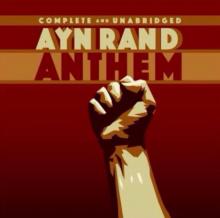 Anthem
Anthem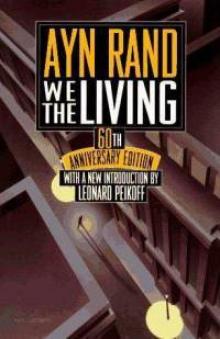 We the Living
We the Living Atlas Shrugged
Atlas Shrugged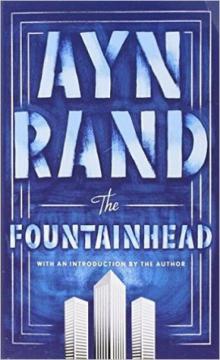 The Fountainhead
The Fountainhead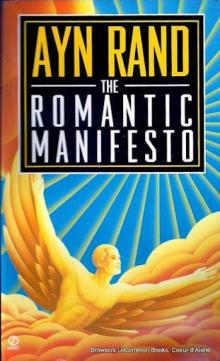 The Romantic Manifesto: A Philosophy of Literature
The Romantic Manifesto: A Philosophy of Literature The Classic Sci-Fi Collection
The Classic Sci-Fi Collection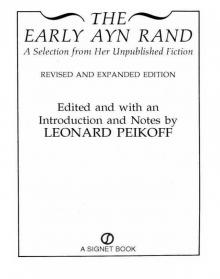 The Early Ayn Rand
The Early Ayn Rand